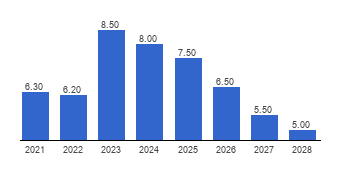In recent months, Pakistan’s economy has experienced significant fluctuations, influenced by various internal and external factors. Amid these challenges, one of the most encouraging developments has been the 4.68% growth in large-scale manufacturing (LSM) reported by the Pakistan Bureau of Statistics (PBS). This growth not only reflects the resilience of the manufacturing sector but also points towards potential recovery and expansion in the country’s economy. In this article, we will explore the factors contributing to this growth, the sectors driving it, challenges facing the manufacturing industry, and its implications for Pakistan’s overall economic landscape.
Understanding Large-Scale Manufacturing (LSM)
Large-scale manufacturing refers to the production of goods on a large scale, typically characterized by the use of advanced technology, substantial investment, and a workforce that can range from hundreds to thousands of employees. This sector is critical to the economy as it contributes significantly to GDP, employment, and exports.
LSM encompasses various industries, including textiles, automobiles, electronics, pharmaceuticals, and food processing. The growth in LSM is often seen as a barometer for the health of the broader economy, as it can lead to job creation, increased production capacity, and enhanced export potential.
Factors Contributing to Growth in LSM
Several factors have contributed to the remarkable growth of 4.68% in Pakistan’s large-scale manufacturing sector. These factors include:
1. Government Policies and Incentives
The Pakistani government has introduced various policies aimed at promoting industrial growth. These include tax incentives, subsidies for energy costs, and initiatives to facilitate access to finance for manufacturers. The government’s focus on enhancing the business environment has encouraged both local and foreign investments in the manufacturing sector.
2. Increased Domestic Demand
The rise in domestic demand for consumer goods has played a crucial role in driving LSM growth. As the middle class expands and purchasing power increases, demand for various products, from textiles to electronics, has surged. Manufacturers have responded by ramping up production to meet this growing demand.
3. Export Opportunities
The global economic recovery following the pandemic has opened new export opportunities for Pakistani manufacturers. Countries looking to diversify their supply chains have turned to Pakistan for various goods, particularly in textiles and apparel. The increase in exports has further stimulated production in the LSM sector.
4. Technological Advancements
Adoption of modern technologies has transformed production processes in many manufacturing industries. From automation to data analytics, manufacturers are increasingly leveraging technology to enhance efficiency, reduce costs, and improve product quality. This technological shift has positioned many firms to respond better to market demands.
5. Investment in Infrastructure
Recent investments in infrastructure, such as roads, energy, and transportation, have made it easier for manufacturers to operate efficiently. Improved infrastructure facilitates the movement of goods and reduces logistical costs, making manufacturing more attractive.
Sectors Driving LSM Growth
The growth in Pakistan’s LSM can be attributed to several key sectors that have shown remarkable performance:
1. Textiles and Apparel
The textile industry is a cornerstone of Pakistan’s economy, accounting for a significant portion of LSM. In recent months, the sector has benefited from increased global demand, particularly from countries looking for sustainable and ethical sourcing. The government has also provided incentives to boost exports, leading to an uptick in production.
2. Automobiles
The automobile sector has witnessed substantial growth, fueled by rising domestic demand and investment from both local and foreign players. With the introduction of new models and a focus on electric vehicles, this sector is poised for further expansion.
3. Pharmaceuticals
The pharmaceutical industry has gained momentum, driven by increased healthcare spending and a growing population. The COVID-19 pandemic highlighted the importance of local manufacturing capabilities, prompting investments in this sector.
4. Electronics
As technology adoption increases, the electronics sector has seen growth in demand for consumer electronics and appliances. The rise of e-commerce has also contributed to increased sales of electronic goods.
5. Food Processing
The food processing industry has experienced growth due to changing consumer preferences and an increasing focus on value-added products. As the population grows, the demand for processed and packaged foods continues to rise, prompting manufacturers to expand their operations.
Challenges Facing the Manufacturing Sector
Despite the encouraging growth in LSM, the manufacturing sector in Pakistan faces several challenges that could hinder its long-term sustainability:
1. Energy Shortages
One of the most significant challenges for manufacturers in Pakistan is the persistent issue of energy shortages. Frequent power outages and high electricity costs can disrupt production processes, leading to increased operational costs and reduced competitiveness.
2. Regulatory Hurdles
The manufacturing sector is often burdened by complex regulations and bureaucratic processes. Streamlining these regulations and reducing red tape is crucial to fostering a more conducive business environment.
3. Access to Finance
While government initiatives aim to facilitate access to finance, many manufacturers, especially small and medium enterprises (SMEs), still face challenges in securing funding. Limited access to credit can hinder expansion and innovation.
4. Skill Gap
There is a pressing need for a skilled workforce in the manufacturing sector. The mismatch between the skills possessed by graduates and the demands of the industry poses a challenge to productivity and growth.
5. Global Economic Uncertainties
The manufacturing sector is also vulnerable to global economic uncertainties, including fluctuations in demand, supply chain disruptions, and geopolitical tensions. Manufacturers must remain agile and adaptive to navigate these challenges.
Implications for Pakistan’s Economy
The growth of large-scale manufacturing has significant implications for Pakistan’s overall economic landscape:
1. Job Creation
As the LSM sector expands, it has the potential to create numerous job opportunities across various skill levels. This job creation is crucial for addressing unemployment and improving living standards.
2. Increased Exports
A robust manufacturing sector can contribute to a favorable trade balance by increasing exports. As Pakistan enhances its manufacturing capabilities, it can capitalize on global market opportunities, leading to increased foreign exchange earnings.
3. Economic Resilience
A diversified manufacturing sector can enhance the resilience of Pakistan’s economy. By reducing dependence on a few sectors, the economy can better withstand external shocks and fluctuations.
4. Attracting Foreign Investment
The growth of LSM can attract foreign direct investment (FDI) as international investors seek to tap into Pakistan’s potential. A thriving manufacturing sector can enhance investor confidence and foster economic growth.
5. Technological Advancements
The focus on modernizing the manufacturing sector can drive technological advancements and innovation. Embracing new technologies can lead to increased efficiency and competitiveness.
The reported 4.68% growth in Pakistan’s large-scale manufacturing sector is a beacon of hope for an economy grappling with numerous challenges. The factors driving this growth, including government support, increased domestic demand, and export opportunities, highlight the potential for a manufacturing renaissance in Pakistan.
However, to sustain this growth and fully realize its benefits, it is essential to address the challenges that lie ahead. By investing in infrastructure, improving the regulatory environment, and fostering skill development, Pakistan can create a robust manufacturing ecosystem that not only contributes to economic growth but also improves the lives of its citizens.
As the manufacturing sector continues to evolve, it will play a pivotal role in shaping Pakistan’s economic future. With the right strategies and investments, the country can position itself as a competitive player in the global manufacturing landscape, ultimately driving sustainable development and prosperity for all.
#PakistanEconomy #ManufacturingGrowth #LSM #EconomicDevelopment #Textiles #AutomobileIndustry #Pharmaceuticals #ForeignInvestment #SustainableDevelopment







